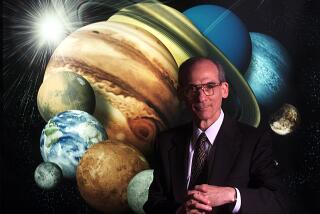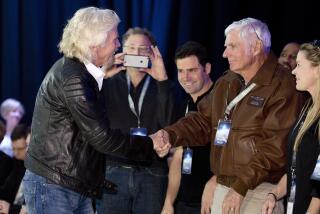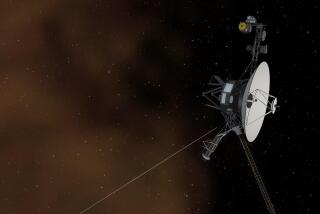NASA confirms Voyager 1’s historic frontier crossing
And we never even got a chance to say goodbye.
After 36 years of space exploration and months of heated argument among scientists, NASA officials confirmed Thursday that Voyager 1 had indeed crossed into interstellar space more than a year ago.
The final piece of evidence that led scientists to conclude the spacecraft had crossed the historic threshold arrived in the form of an other-worldly radio transmission recorded on Voyager’s vintage eight-track tape recorder this spring.
“It’s the first spacecraft to reach interstellar space,” said Ed Stone, a Voyager project scientist at Caltech and former chief of the Jet Propulsion Laboratory in La Cañada Flintridge, where the craft was built. “Think of that. It’s really something that’s mind-boggling.”
Proof of the feat was published Thursday in the journal Science, and focused on two very distinct vibrations that were picked up by Voyager’s 30-foot whip antennas.
In what scientists described as a double-stroke of good luck, the antennas were able to convert the density of surrounding space plasma into audio signals — along with the help of two immense and well-timed solar flares.
“We literally jumped out of our seats when we saw the data,” said lead study author Don Gurnett, a University of Iowa space physicist and Voyager project scientist. “It was clear that we were in the interstellar medium.”
Gurnett and his colleagues concluded that Voyager left the heliosphere — the bubble-shaped region of space dominated by the sun’s gusting solar winds — on or around Aug. 25, 2012. It is now 11.6 billion miles from Earth.
Some scientists have referred to the edge of the heliosphere as the boundary of the solar system. But technically speaking, NASA scientists said the solar system extends out to the Oort Cloud, a distant spherical shell that is believed to be the birthplace of many comets.
Voyager 1, which launched in 1977, will not reach the inner edge of the Oort Cloud for another 300 years, and it could take as long as 30,000 years to exit it, according to NASA.
Scientists have been vigorously debating Voyager’s whereabouts since March, when it became clear the probe was being bombarded by an increasing number of galactic cosmic rays while the number of high-energy particles emanating from the sun had plummeted.
Stone and other NASA scientists, however, said they could not be certain Voyager had entered interstellar space until the magnetic fields surrounding the craft had changed direction.
After waiting for that change for more than a year, Stone conceded this week that Voyager had yet again proved scientists wrong.
“It’s a big surprise, and it’s another mystery,” Stone said. “This is not what our models were telling us.”
Confusion over Voyager’s whereabouts has a lot to do with the failure of a specific piece of equipment known as the plasma science experiment, or PLS. The device, which was developed at the Massachusetts Institute of Technology, measures the electron density of space plasma — ionized gas that is ejected from the sun, as well as from other stars.
Cool plasma, the product of stars that exploded millions of years ago, populates interstellar space. It has a high density of about 100,000 electrons per cubic meter of space, Gurnett said.
Super-heated plasma, like the solar wind that flows from our sun, fills the heliosphere. It is much less dense, with only about 1,000 electrons per cubic meter.
A functioning PLS would have been able to sense the density change as Voyager exited the heliosphere.
“The instrument failed in 1980, so the spacecraft is sort of instrument-challenged,” Gurnett said. “That’s one of the major failures we’ve had. There really aren’t that many.”
Voyager does have two functional plasma wave antennas that stretch from its base and form a wide “V.” The antennas detect the vibration of excited plasma particles and convert that motion into an audible ringing that is stored on the eight-track tape.
The frequency of the ring is associated with a specific density of plasma. The higher the frequency, the denser the plasma.
The only trouble is, something has to excite the plasma to get it to “ring” — something like a large solar flare or coronal mass ejection. Waiting for such a solar event can take years. And when it does occur, it can take as long as a year for the shock wave to reach Voyager.
Fortunately for Voyager scientists, the antennas picked up two long-lasting oscillations in the last year — one in October and November 2012 and another in April and May 2013. In both cases, the frequency suggested that the plasma was cold and dense. Voyager was in interstellar space.
“It was key evidence,” Stone said. “We really needed to measure plasma to know if we were inside or outside the heliosphere. Everything else is more of a proxy.”
Gurnett and his colleagues arrived at the crossing date of Aug. 25 by extrapolation.
Plasma density was increasing in a linear fashion as Voyager moved farther into interstellar space. The frequency measured in the fall of 2012 was 2.2 kilohertz, and by the spring of 2013 it had risen to 2.6 kilohertz.
Previous research told Gurnett that the frequency at the crossing point should be 2 kilohertz. By plotting each point on a line, he was able to arrive at a date.
It’s no small coincidence that it was the exact date given in March by Bill Webber, a professor emeritus of astronomy at New Mexico State University. Webber, another Voyager project scientist, was the first to break from the official line and publish a paper suggesting the probe had left the heliosphere. A media frenzy ensued.
Marc Swisdak, a space plasma physicist at the University of Maryland, also argued that Voyager had entered interstellar space more than a year ago. In a study published last month in Astrophysical Journal Letters, he presented a theory to explain why the craft hadn’t noticed a change in magnetic fields.
Swisdak, who was not involved in the most recent study, said the new evidence looked “fairly conclusive.”
“Density measurement is not quite a smoking gun, but it’s pretty close to it,” he said. “It’s pretty clear that we’ve crossed some sort of boundary.”
Scientists are hoping that many gaps in their understanding will be filled in by Voyager 2. The sister spacecraft, which also launched in 1977, is nearing the edge of the heliosphere via a different path and is expected to encounter interstellar space within the next several years.
Unlike Voyager 1, however, Voyager 2 has a fully functioning plasma science instrument and has been sending back density readings throughout its journey.
“I think it’s going to teach us even more,” Stone said. “We’ve entered a new era of exploration.”







